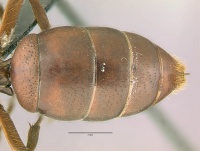Eciton mexicanum panamense
| Eciton mexicanum panamense | |
|---|---|

| |
| Scientific classification | |
| Kingdom: | Animalia |
| Phylum: | Arthropoda |
| Class: | Insecta |
| Order: | Hymenoptera |
| Family: | Formicidae |
| Subfamily: | Dorylinae |
| Genus: | Eciton |
| Species: | E. mexicanum |
| Subspecies: | E. mexicanum panamense |
| Trinomial name | |
| Eciton mexicanum panamense Borgmeier, 1955 | |
Identification
Distribution
Distribution based on Regional Taxon Lists
Neotropical Region: Panama (type locality).
Distribution based on AntMaps
Distribution based on AntWeb specimens
Check data from AntWeb
Countries Occupied
| Number of countries occupied by this species based on AntWiki Regional Taxon Lists. In general, fewer countries occupied indicates a narrower range, while more countries indicates a more widespread species. |

|
Estimated Abundance
| Relative abundance based on number of AntMaps records per species (this species within the purple bar). Fewer records (to the left) indicates a less abundant/encountered species while more records (to the right) indicates more abundant/encountered species. |

|
Biology
Castes
Nomenclature
The following information is derived from Barry Bolton's Online Catalogue of the Ants of the World.
- panamense. Eciton mexicanum subsp. panamense Borgmeier, 1955: 257, pl. 55, figs. 5, 9 (s.w.) PANAMA (Barro Colorado I.).
- Type-material: holotype queen, paratype workers (number not stated).
- Type-locality: holotype Panama: Canal Zone, Barro Colorado Island, 29.iii.1946 (Scheirla); paratypes: workers with same data, workers Panama: Pequeni River (Schneirla), workers Panama: Canal Zone, Ancon, Coconut Palms (Zetek).
- Type-depository: MZSP.
- Subspecies of mexicanum: Kempf, 1972a: 103; Bolton, 1995b: 185.
- Distribution: Panama.
Taxonomic Notes
Borgmeier (1955) described a subspecies Eciton mexicanum panamense from central Panama, based on workers and queen. He differentiated panamense from mexicanum s. str. as follows (my translation): "The soldier differs from mexicanum s. str. by the shorter scapes (1.84mm), shorter funiculus, shorter mandible (3mm) and smaller postpetiole (0.56mm broad posteriorly), and by a well developed anteroventral petiolar tooth (also present on the available minor workers, while it is missing or very short on the workers of mexicanum s. str.)." His key to the queens differentiated the forms as follows:
Petiolar horns with approximately parallel sides, dorsal longitudinal sulcus broad and deep: mexicanum s. str.
Petiolar horns tapered posteriorly, dorsal longitudinal sulcus narrow and shallow: panamense.
The degree of development of the anteroventral petiolar tooth is highly variable among the Costa Rica material I have examined, from nearly absent to well developed. I consider panamense a junior synonym of mexicanum until evidence to the contrary.


